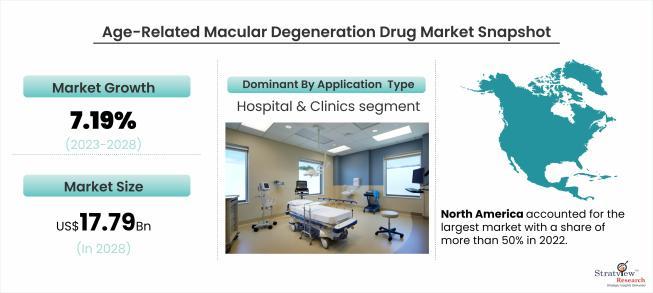The Global Age-Related Macular Degeneration (AMD) Drug Market: Trends, Growth, and Future Prospects

Age-related macular degeneration (AMD) is a progressive eye disease that affects the macula, the central part of the retina responsible for sharp central vision. While there is currently no cure for AMD, there are several drugs available for its treatment.
One of the commonly used drugs for treating AMD is called anti-vascular endothelial growth factor (anti-VEGF) medication. These drugs work by inhibiting the growth of abnormal blood vessels in the retina, which are characteristic of the wet form of AMD. By blocking the action of VEGF, a protein that promotes the growth of new blood vessels, these medications help slow down the progression of the disease and prevent further vision loss.
The Global Age-Related Macular Degeneration Drug Market is estimated to grow from USD 11.66 billion in 2022 to USD 17.79 billion by 2028 at a CAGR of 7.19% during the forecast period.
Age-related macular degeneration (AMD) is one of the leading causes of vision loss in individuals over the age of 50, affecting millions worldwide. AMD is a progressive eye disease that targets the macula, the central part of the retina responsible for sharp vision. As the global population ages, the prevalence of AMD continues to rise, driving the demand for effective treatments and fueling growth in the AMD drug market.
The global AMD drug market is segmented into two primary types of AMD: dry (non-neovascular) AMD and wet (neovascular) AMD. Dry AMD is more common but lacks effective treatment options, leading to significant market potential for the development of therapies. Wet AMD, though less common, has seen more advanced treatment developments, especially with the introduction of anti-VEGF (vascular endothelial growth factor) therapies such as Lucentis (ranibizumab), Eylea (aflibercept), and Avastin (bevacizumab). These treatments have revolutionized wet AMD management by reducing vision loss and, in some cases, improving visual acuity.
The market is expected to see continued expansion, driven by technological advancements, a growing elderly population, and an increasing number of clinical trials. In addition to anti-VEGF therapies, novel treatment modalities are emerging, including gene therapy, stem cell therapy, and complement inhibitors aimed at addressing both wet and dry forms of AMD. Pharmaceutical companies are investing heavily in research and development to bring these new therapies to market.
However, challenges persist, including high treatment costs and the need for repeated injections in the case of anti-VEGF drugs, which can be burdensome for patients. As a result, there is a growing demand for longer-lasting therapies and treatments that can be administered less frequently.
In conclusion, the AMD drug market is poised for significant growth, driven by advances in therapeutic options and a growing patient population. With continued innovation, the market holds the potential to improve the quality of life for millions suffering from this debilitating condition.
To get detailed information about the market dynamics, Register here: https://www.stratviewresearch.com/Request-Sample/1871/age-related-macular-degeneration-drug-market.html#form
- Art
- Causes
- Crafts
- Dance
- Drinks
- Film
- Fitness
- Food
- Games
- Gardening
- Health
- Home
- Literature
- Music
- Networking
- Other
- Party
- Religion
- Shopping
- Sports
- Theater
- Wellness


